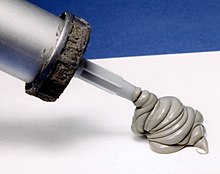| Revision as of 10:36, 30 July 2011 editWOSlinker (talk | contribs)Administrators855,531 editsm image← Previous edit | Revision as of 15:02, 3 October 2011 edit undo173.161.58.229 (talk)No edit summaryNext edit → | ||
| Line 1: | Line 1: | ||
| {{For|horseshoes, see ]. For the process used in computer-game level creation|Caulking (computer games)}} | {{For|horseshoes, see ]. For the process used in computer-game level creation|Caulking (computer games)}} | ||
| ''' |
'''Cocking''' is one of several different processes to ] joints or seams in various structures and certain types of piping. The oldest form of caulking is used to make the seams in ]en ]s or ships watertight, by driving fibrous materials into the wedge-shaped seams between planks. A related process was formerly employed to join sections of ] ] ]. | ||
| Caulking is also the term to describe the process used to make ]ed iron or steel ships and boilers watertight or steamtight. | Caulking is also the term to describe the process used to make ]ed iron or steel ships and boilers watertight or steamtight. | ||
Revision as of 15:02, 3 October 2011
For horseshoes, see Caulkin. For the process used in computer-game level creation, see Caulking (computer games).Cocking is one of several different processes to seal joints or seams in various structures and certain types of piping. The oldest form of caulking is used to make the seams in wooden boats or ships watertight, by driving fibrous materials into the wedge-shaped seams between planks. A related process was formerly employed to join sections of cast iron sewerage pipe.
Caulking is also the term to describe the process used to make riveted iron or steel ships and boilers watertight or steamtight.
The same term also refers to the application of flexible sealing compounds to close up gaps in buildings and other structures against water, air, dust, insects, or as a component in firestopping. In the tunnelling industry, caulking refers to the sealing of joints in segmental precast concrete tunnels, commonly by using concrete.
Marine use
Wooden ship caulking


Traditional caulking (also spelled calking) on wooden vessels uses fibers of cotton, and oakum (hemp fiber soaked in pine tar). These fibers are driven into the wedge-shaped seam between planks, with a caulking mallet and a broad chisel-like tool called a caulking iron. The caulking is then covered over with a putty, in the case of hull seams, or else in deck seams with melted pine pitch, in a process referred to as paying.
Modern marine sealants are frequently used now in place of the pitch, or even to supplant the oakum and cotton itself.
Iron or steel ship caulking
In riveted steel or iron ship construction, caulking was a process of rendering seams watertight by driving a thick, blunt chisel-like tool into the plating adjacent to the seam. This had the effect of displacing the metal into a close fit with the adjoining piece. Originally done by hand much like wooden vessel caulking, pneumatic tools were later employed. With the advent of electric-arc welding for ship construction, steel ship caulking is truly a lost art.
Boiler use
The same technique described above for making riveted steel or iron ships watertight was also used to make riveted boilers watertight and steamtight.
Building construction



Caulk (calk) can refer either to the caulking substance or to the process of applying it. Caulking as a term has spread to the building trade, meaning the activity of closing up joints and gaps in buildings. The function of caulking is to provide thermal insulation, control water penetration and noise mitigation.
This is mostly done with ready-mixed construction chemicals sold as caulk such as silicone, polyurethane, polysulfide, sylil-terminated-polyether or polyurethane and acrylic sealant. Unlike construction caulk, which is applied where no building movement is expected, a sealant is made of elastomeric materials that typically allow movement of 25% to 50% of the width of the joint. Silicone sealants form a durable, water-tight seal, but are not typically paintable. Some silicone sealants are made to be paintable with certain types of paint such as water or oil-based paints. Other sealants are paintable.
One-component sealants are commonly sold in cartridges which are loaded into a pistol-like caulking gun (opening at the side) or barrel gun (opening at the end) for application. During the tool-working time, which varies by chemistry, the bead can be pressed into the joint so that it can bond with the materials on both sides, and also be smoothed. The time it takes for a chemical sealant to become a rubber is known as the curing time and varies by temperature and humidity. Issues of technique that may not be obvious to first-time users:
- The nozzle must be chopped wide enough to match the intended size of the bead. If the opening in the nozzle is too small, the bead is liable to bunch and is difficult to keep even.
- Common tools are a pointing tool, shaped wood, wet finger or a spoon. Detergent should not be added to the moisture for tooling, since it may drip onto the bond surface, causing a loss of adhesion.
- For neat work, the worker may apply painter's masking tape beforehand, taping off the areas on each side of the joint to catch any surplus, and remove the tape again before the tooling time has expired.
- To prevent three-sided adhesion or to avoid sagging in wide, deep joints, a backer rod made of plastic foam can be pressed into the gap before caulking.
A backer rod can also be used to fill joints in sidewalks and masonry, before caulking. It is composed of a foam roll that is generally about ¼ inch to 1½ inch (6 to 37 mm) thick. The material is rolled into the joints to be sealed and then caulked over.
Energy efficiency
According to the Consumer Federation of America, sealing unwanted leaks around homes is an excellent way to cut home energy costs and decrease the household carbon footprint.
Also, sealing cracks and crevices around homes puts less strain on home appliances and can save time, money and hassle by preventing major repairs. Additionally, increasing the lifetime of homes and appliances also puts less waste and pollution into landfills.
References
- U.S. Coast Guard: Navigation and Vessel Inspection Circular Number 7-01: Procedures for hull inspection and repair on vessels built of riveted construction. Issued 2001-10-09.
- Colvin, Fred H. (1906). The railroad pocket-book: a quick reference cyclopedia of railroad information. New York, Derry-Collard; London, Locomotive Publishing Company (US-UK co-edition). p. C‑9.
See also
External links
- Standards Association of New Zealand, Glossary of Building Terminology, 1979. ISBN 0-473-00035-0
- Recommendations for Selecting and Using Caulks and Sealants in Pest Management (PDF)
- Consumer Federation of America
| Types of tools | |
|---|---|